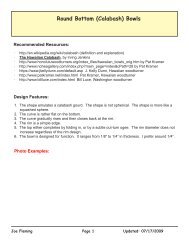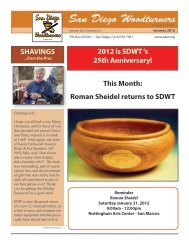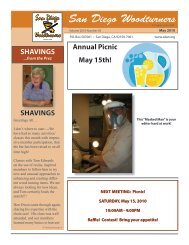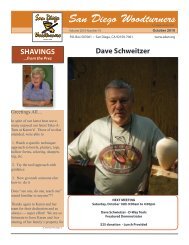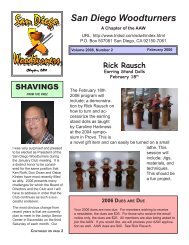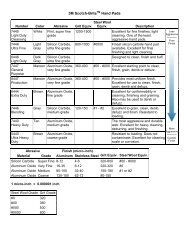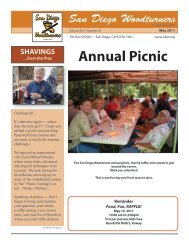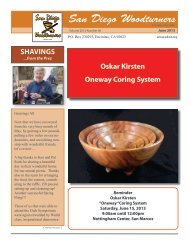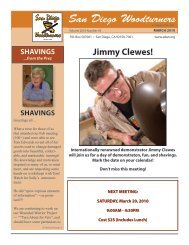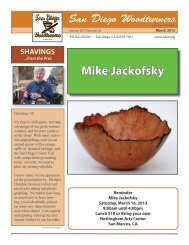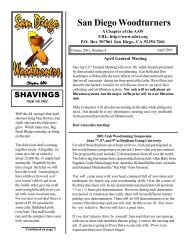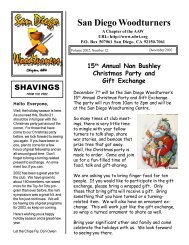March - San Diego Woodturners
March - San Diego Woodturners
March - San Diego Woodturners
You also want an ePaper? Increase the reach of your titles
YUMPU automatically turns print PDFs into web optimized ePapers that Google loves.
<strong>San</strong> <strong>Diego</strong> <strong>Woodturners</strong> Page 17 <strong>March</strong> 2011<br />
Desert Roundup Seminar Reviews<br />
by Mavis Porter<br />
Lyle Jamieson<br />
The basic bowl seminar, which was not that basic because Lyle chose a piece of olive from the crotch of<br />
the tree; it was triangular and selected for its probable good grain.<br />
When he mounted the wood, he used a laser from behind the<br />
headstock to make sure the wood was evenly distributed given<br />
its strange shape. Lyle also emphasized balancing the wood and<br />
tightening the tail stock hard enough so that the wood could not be<br />
moved by hand before turning on the lathe. His other emphatic lesson<br />
was to search out your face plate and do not use the chuck: the<br />
chuck will introduce some wobble. The face plate must have holes<br />
added to it, and the wood must be attached with size 12 x 1 ¼ sheet<br />
metal screws, an impact driver should be used to tighten the screws.<br />
The face plate has to be seated on the tail stock with no padding or<br />
anything else that could introduce wobble. Lyle said he did not know he had so many rules. If you want more<br />
go to www.jamison.com . I also took his hollowing classes which were interesting but mainly emphasized his<br />
patented laser system for knowing how thick the wood is, it works well but I am not sure it is any better than<br />
many of the other systems.<br />
Christian Burchard<br />
How to make balls, or as he prefers, spheres. Like Jaimeson, Buchard eschews the use of a chuck, and prefers<br />
to glue wood onto a block attached to a face plate. He turns the balls by using three perpendicular lines<br />
as guides. I believe he always uses wet wood and very often it is madrone burl, which is plentiful in South<br />
Oregon where he lives. He uses many unconventional methods including drying wood in a microwave, and<br />
putting the balls in a very hot oven to dry before the final turning. He also decorates the balls with various<br />
lines and will move the ball on the face plate by loosening a couple of screws and wedging in underneath to<br />
make asymmetrical patterns. Burchard also makes thin beautiful bowls which are allowed to distort while<br />
drying and are then sand blasted and finished. I took his seminar on design and he showed some very “way<br />
out” designs: in many of these the work on the lathe has to be a very small portion of the total work. I recommend<br />
looking at his web site because I failed to get any good pictures. www.burchardstudio.com He did<br />
recommend a book “Understanding Wood” by Taunton Press.<br />
Mark Sfirri<br />
Off center turning, having taken the class I remain almost as confused, and think the only way to get my head<br />
around it is to play with it. Sriffi makes elongated<br />
bodies, which remind me of those done<br />
by Alberto Giacometti, as well as shapes that<br />
make it very hard to understand how they could<br />
have been turned. I have not found his web site<br />
but his work is readily found by googling his<br />
name. He provided us with a schematic for<br />
making multi-axis candlesticks and a couple of<br />
other projects; I would be happy to fax these<br />
to you or make copies. Mark recommended a<br />
book called “Anatomy for the Artist” unfortunately<br />
there are two books with that title.



